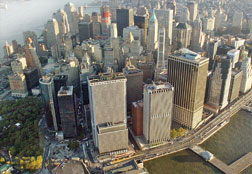The numbers for the ambitious rebuilding of lower Manhattan, sparked by the terrorist attacks of 9/11, are staggering. There are 29 projects worth more than $21 billion expected to be complete by 2015. Nearly half of the 3 million cu yd of concrete and more than half of the 547,500 tons of steel targeted for all New York City jobs will converge in the already congested area at the southern tip of the island. Over the course of the projects, 12,000 workers will commute to jobsites in lower Manhattan, with 5,900 going straight to the World Trade Center.
 |
| (Photo courtesy of AP/Worldwide) |
WTC redevelopment projects alone will gobble up 907, 338 cu yd of concrete and 222,437 tons of steel, aided by 17 tower cranes, 17 mobile cranes and 66 hoists.
These projections were created as part of an unprecedented exercise to "master coordinate" the anticipated deluge of work in the less-than one-square-mile area. The goal is to mitigate the negative impacts of so much activity and to keep the projects rolling.
"This is the first time this has been done for any area," says Charles Maikish, executive director of the city, state and federally funded coordination entity, the Lower Manhattan Construction Command Center.
LMCCC's staff of 16 and its consultants, expected to peak at 30, spent much of the last yearand some of its $71-million, five-year budgetdeveloping projections. LMCCC is using the data to develop a holistic program "to keep lower Manhattan mobile" over the next five years, says Maikish.
 |
Part of LMCCC's charge is to "sell" the concept of cooperation, almost unheard of in New York City, to project sponsors, their builders and real estate and construction groups. There already is buy-in from the owner of the WTC site. "Charlie and I work closely together," says Steven Plate, director of priority capital programs for the Port Authority of New York & New Jersey. PANYNJ is building the $2.2-billion WTC Transportation Hub, as well as other WTC projects.
Tishman Construction Corp., New York City, which is building the WTC's 1,776-ft-tall Freedom Tower, also is conferring with LMCCC and PANYNJ because of complicated logistics and "to coordinate access to the site," says Mel E. Ruffini, Tishman's project director.
|
Through its data, LMCCC has determined, for example, that concrete batch plant capacity is not a concern but supply and timely delivery are extremely worrisome. Supply is limited by the number of delivery trucks. "We are talking to contractors and suppliers about expanding fleets," says Josh Rosenbloom, LMCCC's director of city operations.
Under current conditions, a concrete mixer can make two runs per day from area batch plants. "If we could increase that by 50% to three runs, it would make a huge difference," says Rosenbloom. To decrease travel time, LMCCC is considering dedicated truck lanes on certain area roadways, with security checks at river crossings.
LMCCC also has determined that steel supply is not a concern. Rather than supply, the issue is space for staging, especially in and around the WTC. Labor supply is not a worry because the projects do not all run concurrently. But getting workers to jobsites in a timely manner is a concern.
 |
| Coordinators. Maikish (front row, center) and staff hope to convince different contractors to confer on logistics, deliveries, equipment use, staging. (Photo courtesy of LMCCC) |
To work out logistical issues of mutual concern, LMCCC this month is creating a task force of appropriate government, union and construction industry leaders. Through committees, the task force will tackle seven topics: concrete, steel staging, security, worker transportation, labor, heavy equipment and excavation. Committee leaders will make recommendations for action to the task force.
LMCCC, also charged with enforcing environmental regulations, is focusing on "green" building, community relations and diversity in construction. Standards already are set for construction noise levels. Air quality is monitored. Traffic is managed.
"It's really a quality of life management plan," says Rosenbloom.
 Related Links:
Related Links: 

Post a comment to this article
Report Abusive Comment